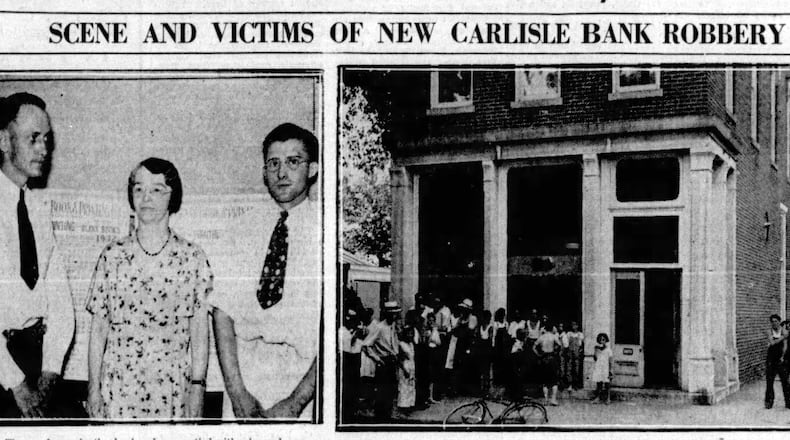Between September 1933 and July 1934, the FBI says Dillinger and his gang killed 10 men, wounded seven others, and robbed about a dozen more banks.
Dillinger became “Public Enemy No. 1″ on the FBI’s most wanted list.
On parole and looking for money
In June 1933, John Dillinger was recently paroled from the Indiana State Prison.
He needed money to bribe guards to help his friends escape from prison.
Dillinger joined up with a gang of 2-3 other men and made his way to the New Carlisle National Bank at the corner of Main and Jefferson streets.
It was reported that the men got into the building though a window the night before and spent the night there waiting for the time locks to open in the morning.
Three employees on duty
The opening shift at the bank that morning were Horace Grisso, Carl Enochs and Mata Taylor. Mata was filling in for her sister, Maude, who was supposed to work that day but was at home, recuperating from a hospital visit.
Enochs, a cashier, was the last to arrive that morning, and found it odd that the other workers had not yet opened the front door.
The reason they had not opened up yet was because Dillinger and his gang already had them under gunpoint.
Taylor was on the floor behind the counter, tied with telephone wire, and Grisso was unsuccessfully trying to open the bank vault.
As Grisso struggled to open the safe, one of the gunmen reportedly said, “Let me drill him; he’s stalling.”
Dillinger is said to have added, “Open the inner compartments of this safe, and do it in a hurry, or you’ll get yours.”
“I’m a new clerk here,” pretended Grisso, “and don’t know much about this safe.”
It was Grisso’s hope he could “stall off” the robbers until Enochs arrived, but that didn’t help. Enochs and an early customer were also quickly brought under the gang’s control.
Unlucky customer
T.G. Widener arrived at the bank early that day. The young farmer sat down on the steps outside and was waiting for the bank to open at 9 a.m.
Enochs finally opened the doors and invited him inside to sit down. The next thing Widener knew, there was a gun to his back.
“I never saw the fellow who stuck the gun in my ribs and I didn’t look around,” he said. “They told me to go back of the counter and lie down. Then they tied my hands and feet, using telephone wire.”
During the robbery, one of the men warned Widener, “You hadn’t ought to come in the bank so early.”
“I heard them threaten to shoot Enochs if he didn’t open the vault,” Widener said.
• RELATED: The history of John Dillinger’s 1933 arrest in Dayton
The getaway
Dillinger and his men finally got what they came for.
The men got away with silver and currency bills worth over $10,000. The men left behind $200 worth of pennies and some Liberty bonds.
Credit: file art
Credit: file art
A neighbor reported seeing a fourth member of the gang, who was outside with the getaway car.
As the men drove away, they scattered roofing nails for about a mile along their escape route, fleeing down Route 71 and out of New Carlisle.
Fruitless investigation
Police found out the type of car and a partial license plate number, but were unable to make any successful arrests. Three suspects were briefly brought in before being released.
As the Dillinger crime spree continued, authorities tried to link Dillinger and his gang to the New Carlisle crime.
Grisso was later able to identify Dillinger as the hold-up man, but only based on the thickness of his forearms.
Enochs said Dillinger resembled the bandit in many ways, but that the robber had a handkerchief over his chin the whole time and that made positive identification difficult.
Built in 1882, the building, at 100 E. Jefferson St. is now occupied by Abe’s Hidden Treasures, a candle shop that offers a wide variety of gifts.
About the Author




